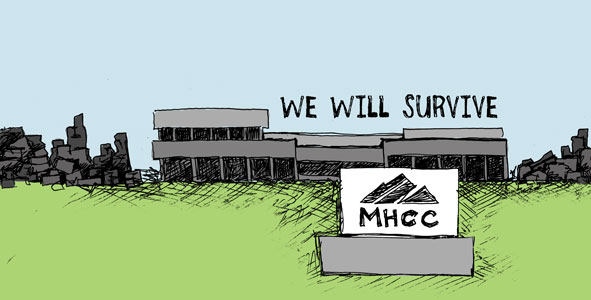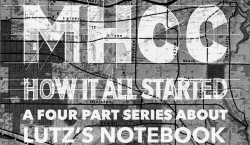Mt. Hood’s Gresham campus built to survive quakes
According to lengthy descriptions in the notebook of architect Donald Lutes, acquired by current Mt. Hood President Debbie Derr this winter, the Gresham campus is structurally sound when it comes to seismic activity.
Lutes’ notebook includes meticulous details about how the college was built, including the construction materials used in his design of the college layout in 1966.
Jim Zordich, an MHCC District board member and caretaker of Lutes’ notebook, said today’s campus has obvious physical deterioration issues. However, the “seismic uncertainty of the college was put to rest,” Zordich said.
According to language in the notebook, Mt. Hood’s main Academic Center, Industrial Technology and Health/P.E. buildings have a structural-steel superstructure, or core framework, that should protect the college in case of a strong seismic event. Zordich said that, much like the steelwork in a skyscraper, Lutes used I-beams in his design.
I-beams are used as major support trusses in modern construction, to ensure that a structure will be physically sound. However, “steel can fail catastrophically if exposed to heat,” according to wisegeek.com. This makes it necessary to insulate the beams for safety.
But, how much trust can be placed in a book that was written nearly 50 years ago?
This should certainly help: The college last summer hired a company named EMG, an organization that provides engineering and environmental consulting work, and what the firm found seems to back up the notebook’s confident language.
The firm found that the Mt. Hood superstructure was tied together, in the sense that steel framing from the walls goes up into the roof deck appropriately. MHCC Vice President Rick Doughty said, “That is somewhat unusual for a building built in the ’60s.”
Doughty said EMG also found a structural component going throughout the school’s brick material, most likely (steel) rebar. The combination of a steel superstructure and reinforced concrete makes the Academic Center one of the safest places to be during an earthquake, it turns out.
Said Zordich, “To be honest, I think this is the strongest and probably the most well-built facility, of any facility in Gresham.”
Another company, KPFF Consulting Engineers, will be coming out this year to confirm the findings of both EMG and Lutes’ notebook. Doughty said KPFF will take a section of the Academic Center, “including the Library,” and verify that it is safe according to FEMA (federal emergency management) seismic standards.
If the apparent good news proves true, the biggest cost in seismic retrofitting would no longer be needed for MHCC. More money from a proposed, publicly funded bond measure in 2016 could go toward other needs, instead.
Doughty explained: “Usually retrofitting your college up to seismic standards costs $30 million. If the heavy lifting has been done (as in Mt. Hood’s case), then it will only be (close to) $5 million.”
This $5 million would go to relatively minor changes, such as securing the roof and bracing pipes. And, Doughty urged the Mt. Hood community to remember that “the Maywood and Bruning centers would also be included in the retrofitting.”
Part One – MHCC: How it all started
Part Two – Exploring the life of Mt. Hood’s principal architect
Part Three – Mt. Hood’s Gresham campus built to survive quakes
Part Four – College to reach crucial milestone in time for bond
To view more of Donald Lutes’ notebook. click here.



Leave a comment